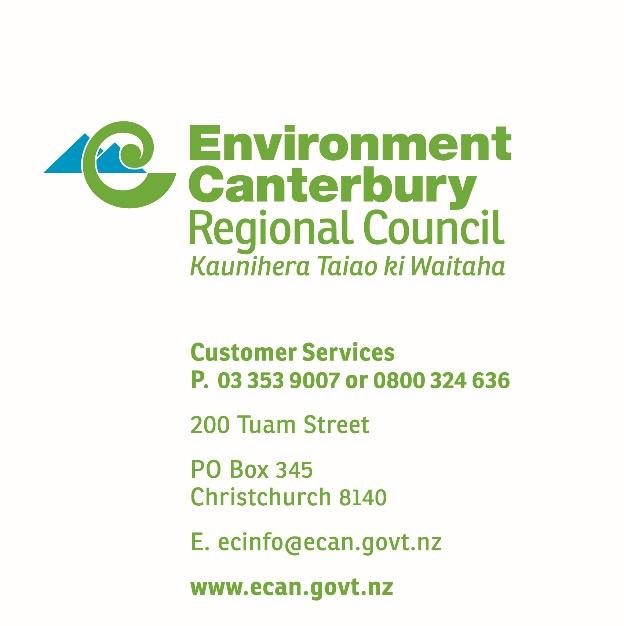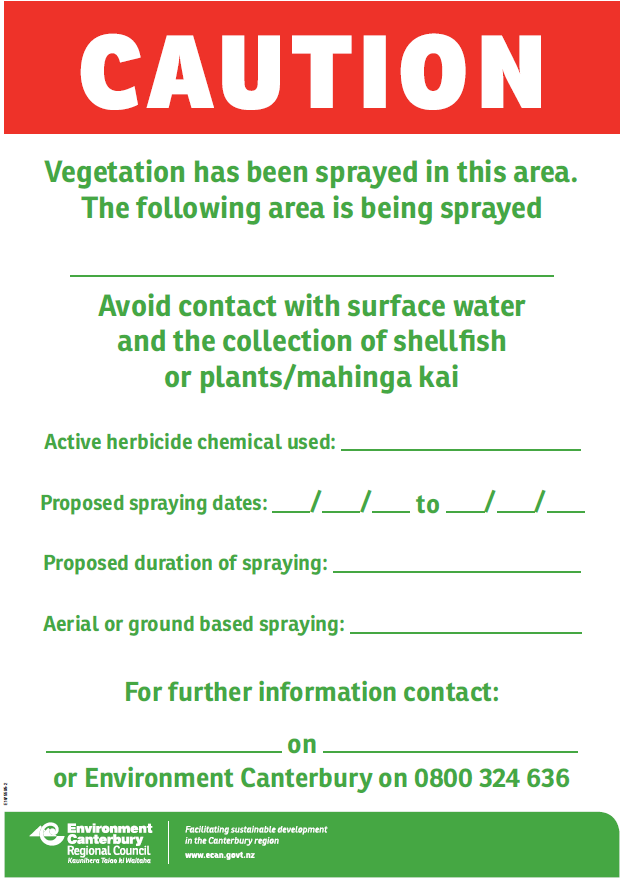
18 September 2018
Mr Graham Carter
By email: [FYI request #8548 email]
Dear Graham
Local Government Official Information and Meetings Act 1987 (“LGOIMA”):
Request for Information
I refer to your email dated 22/08/18 requesting information on spraying around waterways.
Your request has been referred to me to reply.
Please find below the answers to your questions in relation to spraying on and around the
Rakaia River. Our River Engineering team maintain only a small portion of the Styx River,
downstream of the floodgates (where it enters the Waimakariri River under the stopbank),
and there is no routine spraying here. For information regarding spraying on and around
the Styx River I suggest you contact the Christchurch City Council (CCC).
1. You ask for the exact names of the chemicals used to spray on the foliage around
waterways and the application rate of each.
Environment Canterbury holds resource consent CRC981580 which authorises the
application of triclopyr, glyphosate and surfactants to river beds in Canterbury.
While all products used are either triclopyr or glyphosate based, the exact product name
may vary from year to year depending on which suppliers have been selected during
chemical procurement. Surfactants used are either Organosilicone or canola oil-based
products like Kwicken.
During 2017-2018 the following chemicals were used to spray in the Rakaia River:
• Nufarm Lion 490 DST - Glyphosate
• MAX-Spred - Organosilicone surfactant
• Kenso 600 - Triclopyr
The fairway (active part of the bed between the berms) is sprayed with glyphosate and the
surfactant, and tracks within the berm are sprayed with glyphosate and triclopyr (triclopyr
is not used in the fairway). The application rate can vary depending on the weed infestation
to be treated, however the typical application rate is 12L/Ha (min rate 6.4L/Ha, max rate
17L/Ha) for Glyphosate and 1.5L/Ha for Organosilicone.
File Number: GOVE/INQU/OMBU/1420C

2. You ask what signage is put up when the areas are being sprayed.
Signs are put up on the access points to tracks when spraying tracks, and these are kept
in place until vegetation is starting to show signs that it has been sprayed. We also
communicate this to North Canterbury Fish and Game.
Below is an image of the sign that is used, with site specific information added at the time
of spraying:
3. You ask what water testing is carried out after an application of spraying has
been undertaken and whether or not the surfactants are tested.
The sampling as specified on our resource consent is:
In areas where triclopyr has been discharged –
(a) Samples of water shall be taken from channels containing flowing water within 25
metres downstream and immediately upstream of the spray area. Samples shall be taken
as follows:
(i) One upstream sample shall be taken immediately prior to spraying;
(ii) One downstream sample shall be taken upon the conclusion of spraying; and
(iii) One downstream sample shall be taken within 40 days of the conclusion of
spraying and following sufficient rainfall on river flow to result in surface water
movement over the sprayed area.
(b) The samples taken in accordance with (a)(ii) and (iii) shall be analysed for triclopyr.
File Number: GOVE/INQU/OMBU/1420C
(c) The sample taken in accordance with Condition (a)(i) shall be analysed for triclopyr only
if the samples taken in accordance with either (a)(ii) or (iii) show a result that is greater
than or equal to the maximum concentration specified in Condition 7(ii). (that being
0.01g/m3)
(d) If the analysis of the samples taken in accordance with Condition(a)(ii) or (iii) shows
that the concentration of triclopyr does not exceed the concentration specified in Condition
(7)(ii), the results shall be provided to the Canterbury Regional Council within 10 working
days of receipt of the results by the consent holder.
(e) If the analysis of the sample taken in accordance with (20)(a)(i) or (20)(a)(ii) shows that
the concentration of triclopyr determined exceeds the concentration specified in Condition
(7)(ii), the consent holder shall:
(i) Notify the Compliance Monitoring Section of the Canterbury Regional Council
within two working days of receipt of the results by the consent holder; and
(ii) Implement all practicable measures to reduce the concentration of the
contaminant in the receiving environment. Without limitation such measures may
include cessation of activities that may have caused the exceeding concentration,
or removal of contaminant source(s), or review of discharge procedures. The
measures to be implemented shall be reported to the Compliance Monitoring
Section of Canterbury Regional Council along with the notice of the results under
(e)(i).
In areas where glyphosate has been discharged –
(a) Samples of water shall be taken from channels containing flowing water within 25
metres downstream and immediately upstream of the spray area. Samples shall be taken
as follows:
(i) One upstream sample shall be taken immediately prior to spraying,
(ii) One downstream sample shall be taken upon the conclusion of spraying.
(b) The samples taken in accordance with (a)(ii) shall be analysed for glyphosate.
(c) The sample taken in accordance with Condition (a)(i) shall only be analysed for
glyphosate if the sample taken in accordance with Condition(a)(ii) shows a result that is
greater than or equal to the maximum concentration specified in Condition (7)(i). (that being
0.1g/m3)
(d) If the analysis of the samples taken in accordance with Condition(a)(ii) shows that the
concentration of glyphosate does not exceed the concentration specified in Condition (7)(i),
the results shall be provided to the Canterbury Regional Council within 10 working days of
receipt of the results by the consent holder.
(e) If the analysis of the sample taken in accordance with (a)(i) or (ii) shows that the
concentration of glyphosate determined exceeds the concentration specified in Condition
(7)(i), the consent holder shall:
(i) Notify the Compliance Monitoring Section of Canterbury Regional Council within
two working days of receipt of the results by the consent holder; and
(ii) Implement all practicable measures to reduce the concentration of the
contaminant in the receiving environment. Such measures may include cessation
of activities that may have caused the exceeding concentration, or
removal of contaminant source(s), or review of discharge procedures. The
measures to be implemented shall be reported to the Compliance Monitoring
Section of Canterbury Regional Council along with the notice of the results under
(e)(i).
The sampling is required for 5 sites across the region in any given year, so it is not
guaranteed that there will be sampling done after each spraying event in the Rakaia River.
Triclopyr is not sampled for, as there are typically no flow channels around the tracks to
collect samples from.
File Number: GOVE/INQU/OMBU/1420C
Samples are analysed for glyphosate, surfactants specifically are not tested for as the
resource consent has not required this.
4. You ask what form of triclopyr is used.
Triclopyr butoxyethyl ester is the form that is used.
5. You ask if polyethoxylated tallowamine, or POEA, an ingredient in chemicals
present in any of the chemicals.
No, according to the safety data sheets, POEA is not present in any of the chemicals.
6. You ask for the exact timings of the spraying.
Below are the spraying dates for the last five years:
Upper Rakaia – upstream from
Lower Rakaia – downstream
SH1 Bridge to Rakaia Barrhill
SH1 bridge to mouth
Methven Rd
4/12/2013
4/12/2013
5/12/2013
5/12/2013
11/02/2015
12/01/2015
12/02/2015
13/01/2015
18/02/2015
30/01/2015
11/02/2016
10/02/2015
12/02/2016
11/02/2015
13/11/2017
21/01/2016
15/11/2017
22/01/2016
2/02/2016
9/02/2016
25/10/2017
1/11/2017
2/11/2017
6/11/2017
13/11/2017
7. You ask for access to the results of the water quality testing, and ask what
happens if the weeds don't get sprayed, and if there is an alternative method to
kill the weeds.
The results for water quality testing of the Rakaia River are shown below:
Sample
Sample
Substance
date
location/name tested
Result
No residues
22/02/2007 Before
Glyphosate detected
22/02/2007 after
Glyphosate 0.011mg/kg
9/12/2009 D/S
Glyphosate 0.0090mg/L
No residues
9/12/2009 U/S
Glyphosate detected
No residues
9/12/2009 24 hr after
Glyphosate detected
File Number: GOVE/INQU/OMBU/1420C
25m
Downstream
19/01/2015 before spray
Glyphosate <0.0010mg/kg
25m
Downstream
19/01/2015 after spray
Glyphosate 0.0085mg/kg
25m
Downstream
20/01/2015 after spray
Glyphosate <0.0010mg/kg
22/01/2016 Upstream
Glyphosate <0.0010mg/kg
22/01/2016 Downstream
Glyphosate <0.0010mg/kg
Downstream
25/01/2016 within 72hrs
Glyphosate <0.0010mg/kg
Downstream
11/02/2017 true right
Glyphosate <0.0066mg/kg
Downstream
11/02/2017 true left
Glyphosate 0.043mg/kg
Consent limit - 0.1g/m3 Laboratory Limit of Detection = 0.0010mg/kg If areas are not sprayed, they will either continue to grow and form dense vegetated
islands, or floods will clear weedy growth (if frequent, sufficiently sized floods happen).
Once vegetated islands have established, the natural braiding pattern of rivers can be lost
as the flow gets entrenched into a set pattern, and therefore associated aquatic habitats
are lost. Areas of bare gravel are also lost, which impacts on the nesting success of our
native birds which rely on clear gravels for nesting and raising their chicks. Heavily
vegetated river beds also reduce flood carrying capacity and increase erosion to the river
banks if flows are being deflected by islands. If this happens, typically the only resolution
is mechanical intervention – which can be both very expensive to the local rate payers and
more intrusive to the river environment. Routine spraying can help avoid these effects.
Due to the scale of the Rakaia River, there is no practicable alternative to spraying to
manage weed growth over this significant area of river bed.
8. Finally, you ask what method of delivering the chemicals is used.
The Rakaia River fairway is aerially sprayed by helicopter. Vehicle access tracks within
the berm areas are sprayed via a truck mounted spray unit, with a handheld spray gun.
You will be aware that if you are not satisfied with this response you are able to refer this
matter to the Office of the Ombudsman under s27 (3) of the Local Government Official
Information and Meetings Act 1987.
Please be advised that we now put LGOIMA responses that are in the public interest onto
our website. No personal details of the requester are given, but we do summarise the
essence of the request alongside the response.
Should you require any further information or clarification, please do not hesitate to contact
Anna Paris in the first instan
ce [email address] or 033653828.
File Number: GOVE/INQU/OMBU/1420C

Yours sincerely
Nadeine Dommisse
Director
File Number: GOVE/INQU/OMBU/1420C


